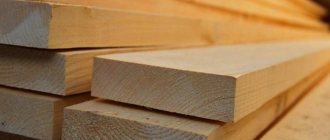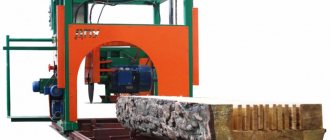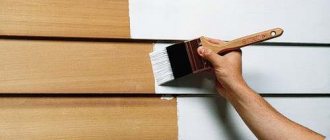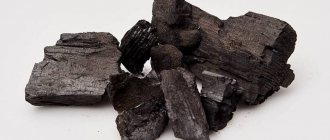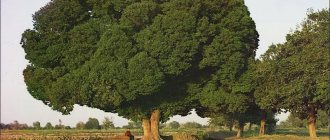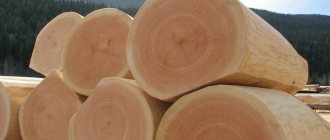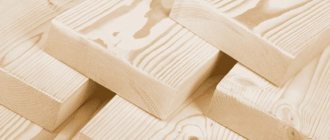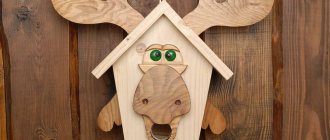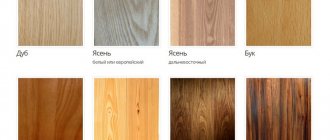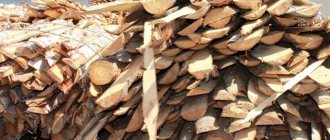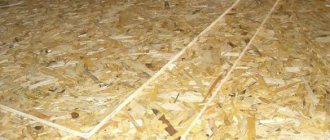Articles
All photos from the article
It is quite difficult to find a construction task for which thin boards would not be used: these products are almost universal, and the variety of shapes and sizes of manufactured parts allows them to be used almost everywhere.
In our article we will talk about the production technology of such material, and also analyze where and for what it can be used.
Every builder needs this material!
Description of building material
Types of lumber
As a result of woodworking, logs are sawn into several pieces of different sizes. At the same time, several different parts can be cut from one blank at once - this way we not only save wood, but also expand the range of products produced.
Lumber can have different shapes and sizes
We describe the main types of products obtained from solid blanks in the table:
| Variety | Description |
| timber | A part with a square or rectangular cross-section (the ratio of length and width is not less than 1:2). The size of the smaller side is 80 mm or more. They are used as frame elements with high load-bearing capacity. |
| Bar | The configuration of the material is similar to timber, but at the same time it has smaller dimensions: the side side is up to 80 mm, the cross-sectional area is up to 32 cm2. The bars are used to form lightly loaded frames, for the manufacture of auxiliary elements, etc. |
| The board is thick | A rectangular product with one cross-sectional side at least twice as large as the other. The thickness of the board is 40 mm or more. Used to form high-strength decking, as well as blanks for the production of flat parts. |
| Thin board | Wooden panel with a width of at least 80 mm and a thickness of 8 to 40 mm. Has a very wide range of applications. |
It is the last variety of lumber listed in the table that is the subject of consideration in our article. This is quite logical, because it is thin boards that make up a significant part of all products used for construction and repair.
Thin board production technology
The manufacturing technique for such parts can be divided into two stages:
- first, blanks of the desired shape and size are made from the log;
- then the blanks are used to form products with the stated parameters and performance properties, for example, a thin terrace board or façade plank.
Log cutting options
The production algorithm itself looks like this:
- Logs are used as raw materials, which undergo primary sorting, calibration and drying. It should be noted that the price of products is largely determined by the wood used: thus, common pine will almost always cost less than rarer and more difficult to process oak.
- The log is fed to the sawmill, where it is sawed in accordance with the task. The cutting is usually carried out along the grain.
Rough cut
Note! Most often, the workpiece is either spread onto unedged boards, or slabs are removed from the surfaces, forming a beam. Then smaller parts are cut from this timber.
- As a result of these actions, we obtain the so-called sawn board, which can already be used in construction.
Additional operations
However, the technological process is not limited to this.
Depending on what material is required, the following operations can be performed:
- drying - carried out either in special chambers or on areas protected from direct sunlight and precipitation. As a result, the moisture content of the wood is reduced, making the products less susceptible to deformation;
Heat treatment of workpieces
- heat treatment – drying, accompanied by exposure of the workpiece to hot steam and high (up to 2000 C) temperatures. After this, we get a so-called thermal board, which can be used for facade work without fear that it will swell upon contact with moisture;
- processing on a planing machine - performed to level all surfaces;
Note! The planed thin board has smooth edges, which allows it to be used for finishing and making various structures without preparation.
- profiling - performed either on a planing or milling machine. At the same time, protrusions and depressions are formed at the ends, which make it possible to connect several parts into a lock.
Milling the lock on the end
How to choose the right variety
Once the wood arrives at the warehouse, it is no longer checked for defects. When purchasing timber, a person must rely on regulatory control and his own knowledge. To make the right choice, you need to study the varietal characteristics and rely only on them.
Often, instead of digital values, wood grades are marked with the letters A, B, C. These designations correspond to the number of defects in the product.
Sometimes you may encounter the fact that a selective class is marked with the number 0, or with an ordinary horizontal line. The first class (1) is indicated by a dot, the second by two dots or two slashes. Third grade (3), by analogy, 3 dots or 3 vertical stripes. Each manufacturer labels their products differently.
Tips for choosing lumber:
If the products are required for outdoor use, then you should pay attention to the absence of deep cracks on them. As for knots, they significantly reduce the mechanical characteristics of wood. Closely spaced growth rings are a sign of material strength
If the rings run parallel to each other, then you can safely make furniture from such wood. Hardwoods are suitable for constructing stairs and flooring. You should not use selected grade timber where second- or third-grade raw materials will do.
You can determine the quality and type of wood visually, but it is better to purchase timber from a trusted supplier.
Types of boards and their use in construction and repair
As we noted at the very beginning, thin lumber is used almost everywhere. But still, if you do the work yourself, you should select wooden blanks that best suit the task at hand.
Thin coniferous board with locks on the ends
We will give a few examples below:
- Unedged boards, as well as planks that have not been processed on a planer, are most often used in rough work. They are used to construct wooden floors and ceilings, temporary partitions, hidden structures, etc. Sometimes these materials are used for the installation of lathing - frames to which this or that finishing material will be attached.
- Planed boards are an excellent raw material for both construction and the furniture industry. It is from planed blanks that carpentry products are made - window and door frames, frames for them, window sills, platbands, furniture panels, etc.
- Thin floorboards, as well as lining, must be equipped with locks at the ends. Thanks to the tongue-and-groove fastening system, we are able to lay a floor or sheathe a wall/ceiling with a minimum number of cracks, ensuring effective thermal insulation.
Photos of the plank floor installation process
- Separately, it is worth mentioning the facade panels. As we noted, the instructions for their manufacture provide for multi-stage processing, which seriously increases the cost of the material. But this produces products that, despite their small thickness, have enviable strength and resistance to external influences.
However, this is only a small part of the problems that can be solved using such products. So the demand for thin boards will continue for a very long time.
GOST standards
Like any other standards, standard sizes of lumber are designated and collected in regulatory documents - GOSTs.
The main document describing these standards is GOST 8486-86. It specifies the technical conditions for the use of coniferous materials, which are the most used in construction.
Issues of technical requirements for boards made of coniferous wood are also regulated by other documents. For example, interstate GOST 24454-80 is key to the issue of sizes and determines the standard sizes of lumber for coniferous species, common in the countries of the former USSR, and GOST 26002-83 describes increased requirements for export types of boards.
GOST 24454-80 contains a table indicating the standard sizes, as well as the principle approach to classification. The topic of sizes should be considered based on this classification, as well as individual examples.
I will buy lumber from pine needles. Notice board for the purchase of coniferous lumber. :: Palki.ru
We buy edged softwood boards with natural moisture content. 1 grade is required, with an allowance of 2-3 mm for drying. Dimensions upon request. With delivery to the Moscow region, Dmitrov. Ready for the long haul
Dmitrov woodworking plant, Moscow and Moscow region, Dmitrov
Let's buy; coniferous boards 1-3 grades of natural humidity 25x150x6 1 grade, 40x150x6 1 grade, 50x150x6 1 grade, 50x200x6 1 grade, 22x150x6 2 grades, 25x150x6 2 grade, 40x150x6 2 grade, 50x150 x6 2nd grade, 25x1
RegionLesExport, Leningrad region and St. Petersburg, St. Petersburg
Required workpiece (disc sawing) from aspen, birch, coniferous species: Based on the supply volume of 5500 m3 per month for 2022. Workpiece cross-section 19(20)*100, 19*120 length 1300 mm - 52% Section for
AEK, Sverdlovsk region, Ekaterinburg
Stroysistema LLC will purchase 1st and 2nd grade softwood lumber (dead wood) on an ongoing basis. Sizes 150*50, 150*25, 150*40, 100*25, 100*50, 100*100, 200*50, 6 meters. Payment form cash/non-cash
Stroysistema, Tula region, Tula
Stroysistema LLC will buy softwood lumber (dead wood, brilliant green), 1st and 2nd grade on an ongoing basis. unedged. sizes 150*50, 150*40, 100*25, 150*25, 100*50, 100*100, 200*50 6 meter
Stroysistema, Tula region, Tula
I will buy 100x100 timber in St. Petersburg of the following types: 1. Coniferous timber (pine, spruce), length 2,500 mm and 3,000 mm, GOST-8486, 1st grade, rubbed pencil wane of no more than 10 mm is allowed 2. Birch timber, d
Convolut, Leningrad region and St. Petersburg, St. Petersburg
We purchase dry and natural moisture coniferous lumber, one of the highest prices in St. Petersburg, since we are not resellers, adequate acceptance at production. We work as with ND
ASD, Leningrad region and St. Petersburg, St. Petersburg
We purchase softwood lumber 1000 mm long, grade 0-1 for the production of pallets and boxes. Demand is year-round, monthly up to 5000 m3. We are looking for reliable suppliers. EGAIS
ORMAN, Penza region, Penza
We purchase unimpregnated white sleepers, type 1 and type 2, of coniferous species. Sleeper beams are pine needles. On an ongoing basis.
SVD, Leningrad region and St. Petersburg, St. Petersburg
We buy softwood lumber. Edged boards of natural moisture edged boards chamber drying dry planed boards calibrated sizes non-standard volumes large, constant
Timber Trading Company Sofia, Moscow and Moscow Region, Moscow
ULTK, Novosibirsk region, Novosibirsk
We purchase planed boards from container boards on an ongoing basis, dimensions 19*70*890; 15*66*796, 896, 1196, 1396. R5. Humidity up to 11%. Needles, wane, fallen knots, cracks, resin pits are not allowed
Lignogroup, Leningrad region and St. Petersburg, St. Petersburg
I buy edged boards 22*98, lengths 1200/2400/3600/4800/6000mm, softwood
Pallets, Moscow and Moscow region, Volokolamsk
StroyKomplekt LLC purchases “white” sleepers type 1 and type 2 (GOST 78-2004) from coniferous species. I accept products at my site; pickup from the seller is possible. Cashless payments.
StroyKomplekt, Sverdlovsk region, Alapaevsk
We purchase on an ongoing basis edged lumber boards of natural moisture from coniferous wood (spruce, pine): 1, 2 grades according to GOST 8486-86 Dimensions of interest (test): * 50 * 150 *
Rakov V.V., Kirov region, Omutninsk
We purchase planed softwood lumber (boards, blocks, imitation logs/beams, tongue and groove). Payment within 1-3 days after acceptance. EGAIS. Cashless, VAT/EXCLUDING VAT. We work without delays in payments all the time
Orlan, Leningrad region and St. Petersburg, St. Petersburg
The company purchases non-impregnated coniferous sleepers, and we will also consider aspen birch, type 1-2, for broad gauge access roads, transfer beams, turnouts. Regions of purchase, Krasnoyarsk Krai
GK D.Les, Krasnoyarsk region, Krasnoyarsk
The organization regularly purchases edged (spruce, pine) dry and natural moisture boards. Interested in long-term cooperation. Only the Vologda region and neighboring regions.
Vologdasnab, Vologda region, Vologda
Species spruce, transport humidity: 32x125x4800-6000, 38x125x4800-6000, 44x100/125/150x4200-6000, 75x150/200x6000 Please send suggestions by e-mail:
Lotus, Estonia, Tallinn
Page:
1
2345678910 .. 25
www.palki.ru
